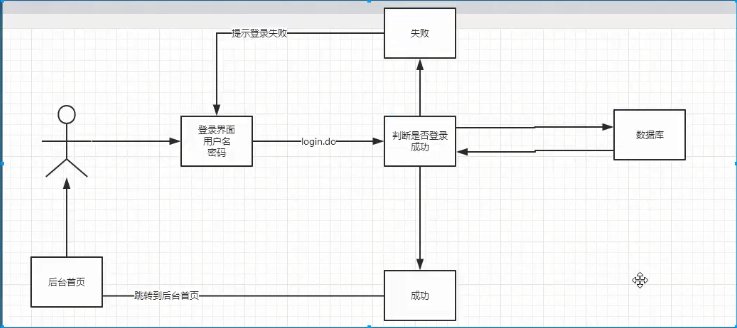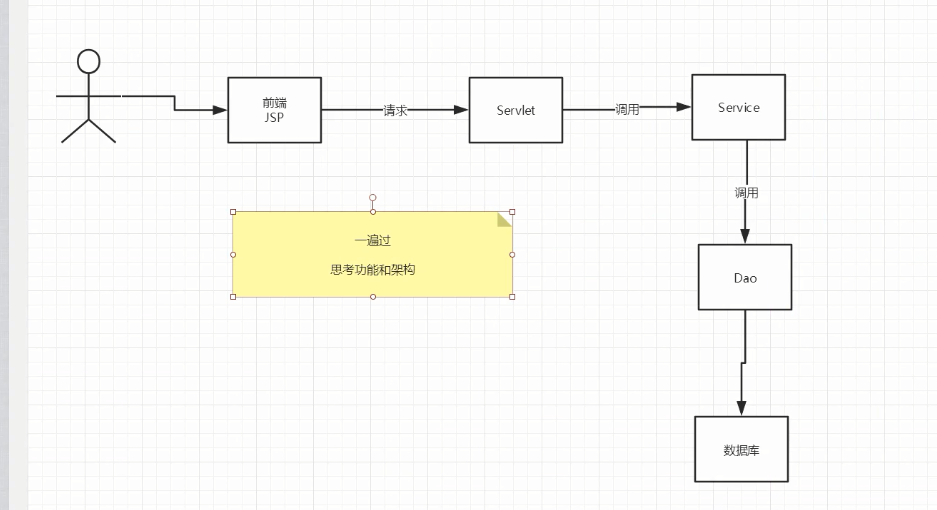smbms项目 狂神 |
您所在的位置:网站首页 › 狂神smbms笔记 › smbms项目 狂神 |
smbms项目 狂神
|
登录页面
编写前端页面 设置首页(欢迎页面) login.jsp编写dao层 登录用户的接口 //得到要登录的用户 public User getLoginUser(Connection connection,String userCode) throws SQLException; }编写dao接口的实现类 public class UserDaoImpl implements UserDao{ public User getLoginUser(Connection connection, String userCode) throws SQLException { PreparedStatement pstm = null; ResultSet rs = null; User user = null; if (connection != null) { String sql="select * from smbms_user where userCode=?"; Object[] params = {userCode};//数组 rs = BaseDao.execute(connection, pstm, rs, sql, params); if(rs.next()){ user = new User(); user.setId(rs.getInt("id")); user.setUserCode(rs.getString("userCode")); user.setUserName(rs.getString("userName")); user.setUserPassword(rs.getString("userPassword")); user.setGender(rs.getInt("gender")); user.setBirthday(rs.getDate("birthday")); user.setPhone(rs.getString("phone")); user.setAddress(rs.getString("address")); user.setUserRole(rs.getInt("userRole")); user.setCreatedBy(rs.getInt("createy")); user.setCreationDate(rs.getTimestamp("creationDate")); user.setModifyBy(rs.getInt("modifyBy")); user.setModifyDate(rs.getTimestamp("modifyDate")); } BaseDao.closeResource(null,pstm,rs); } return user; } }业务层接口 public interface UserService { //用户登录 public User login(String userCode,String password); }业务层实现类 public class UserServiceImpl implements UserService{ //业务层都会调用dao层,所以我们要引入dao层 ; private UserDao userDao; public UserServiceImpl(){ userDao = new UserDaoImpl(); } public User login(String userCode, String password) { Connection connection = null; User user = null; try { connection = BaseDao.getConnection(); //通过业务层调用对应的具体的数据库操作 user = userDao.getLoginUser(connection, userCode); } catch (SQLException e) { e.printStackTrace(); }finally { BaseDao.closeResource(connection,null,null); } return user; } }编写Servlet package com.well.servlet.user; import com.well.pojo.User; import com.well.service.user.UserServiceImpl; import com.well.util.Constants; import javax.servlet.ServletException; import javax.servlet.http.HttpServlet; import javax.servlet.http.HttpServletRequest; import javax.servlet.http.HttpServletResponse; import java.io.IOException; public class LoginServlet extends HttpServlet { //Servlet:控制层,调用业务层代码 @Override protected void doGet(HttpServletRequest req, HttpServletResponse resp) throws ServletException, IOException { System.out.println("LoginSerlet--start..."); //获取用户名和密码 String userCode = req.getParameter("userCode"); String userPassword = req.getParameter("userPassword"); //和数据库中的密码进行对比,调用业务层 UserServiceImpl userService = new UserServiceImpl(); User user = userService.login(userCode, userPassword); //这里已经把登录的人已经查出来了 if (user != null) { //查有此人,可以登录 //将用户的信息放到Session中 req.getSession().setAttribute(Constants.USER_SESSION,user); //跳转到内部主页 resp.sendRedirect("jsp/frame.jsp"); }else {//查无此人 ,无法登录 //转发会登录页面,顺便提示他,用户名或者密码错误; req.setAttribute("error","用户名或者密码不正确"); req.getRequestDispatcher("login.jsp").forward(req,resp); } } @Override protected void doPost(HttpServletRequest req, HttpServletResponse resp) throws ServletException, IOException { doGet(req, resp); } }注册Servlet LoginServlet com.well.servlet.user.LoginServlet LoginServlet /login.do测试访问,确保以上能成功! 登录功能优化注销功能: 思路:移除Session,返回登录页面 public class LogoutServlet extends HttpServlet { @Override protected void doGet(HttpServletRequest req, HttpServletResponse resp) throws ServletException, IOException { //移除用户的Constants.USER_SESSION req.getSession().removeAttribute(Constants.USER_SESSION); resp.sendRedirect(req.getContextPath()+"/login.jsp"); //返回登录页面 } @Override protected void doPost(HttpServletRequest req, HttpServletResponse resp) throws ServletException, IOException { doGet(req, resp); } }注册xml LogoutServler com.well.servlet.user.LogoutServlet LogoutServler /jsp/logout.do 登录拦截优化编写过滤器,并注册 package com.well.filter; import com.well.pojo.User; import com.well.util.Constants; import javax.servlet.*; import javax.servlet.http.HttpServletRequest; import javax.servlet.http.HttpServletResponse; import java.io.IOException; public class SysFilter implements Filter { public void init(FilterConfig filterConfig) throws ServletException { } public void doFilter(ServletRequest req, ServletResponse resp, FilterChain chain) throws IOException, ServletException { HttpServletRequest request = (HttpServletRequest) req; HttpServletResponse response = (HttpServletResponse) resp; //过滤器 从Session获取用户 User user = (User) request.getSession().getAttribute(Constants.USER_SESSION); if (user == null) {//已经移除或者注销,或者未登录 response.sendRedirect("/smbms/error.jsp"); }else { chain.doFilter(req,resp); } } public void destroy() { } }注册过滤器 SysFilter com.well.filter.SysFilter SysFilter /jsp/*测试,登录,注销,权限,都要保证OK! 密码修改导入前端素材 密码修改写项目,建议从底层上去写
UserDao接口 //修改当前用户密码 public int updatePwd(Connection connection,int id,int password) throws SQLException;UserDao接口实现类 public int updatePwd(Connection connection, int id, int password) throws SQLException { PreparedStatement pstm = null; int execute = 0; if(connection !=null){ String sql = "update smbms_user set userPassword = ? where id = ?"; Object params[] = {password,id}; execute = BaseDao.execute(connection, pstm, sql, params); BaseDao.closeResource(null,pstm,null); } return execute; }UserService层 //根据用户ID修改密码 public boolean updatePwd(int id,int pwd);UserService层实现类 public boolean updatePwd(int id, int pwd) { Connection connection = null; boolean flag = false; //修改密码 try { connection = BaseDao.getConnection(); if(userDao.updatePwd(connection,id,pwd)>0){ flag = true; } } catch (SQLException e) { e.printStackTrace(); }finally { BaseDao.closeResource(connection,null,null); } return flag; }记得实现复用,需要提取出方法,注册Servlet @Override protected void doGet(HttpServletRequest req, HttpServletResponse resp) throws ServletException, IOException { String method = req.getParameter("method"); if(method.equals("savepwd") && method != null){ this.updatePwd(req,resp); }//验证旧密码的 else if(method.equals("pwdmodify")&&method!=null){ this.pwdModify(req,resp); } } public void updatePwd(HttpServletRequest req, HttpServletResponse resp){ //从Session里面拿ID Object o = req.getSession().getAttribute(Constants.USER_SESSION); String newpassword = req.getParameter("newpassword"); System.out.println("UserServlet: "+newpassword); boolean flag = false; if(o != null && newpassword != null){ UserService userService = new UserServiceImpl(); flag = userService.updatePwd(((User) o).getId(), newpassword); if(flag){ req.setAttribute("message","修改密码成功,请退出,使用新密码登录"); //密码修改成功,移除当前session req.getSession().removeAttribute(Constants.USER_SESSION); }else { req.setAttribute("message","修改密码失败"); } }else { req.setAttribute("message","新密码有问题"); } try { req.getRequestDispatcher("pwdmodify.jsp").forward(req,resp); } catch (ServletException e) { e.printStackTrace(); } catch (IOException e) { e.printStackTrace(); } }测试 优化密码修改使用Ajax 阿里巴巴的fastjson com.alibaba fastjson 1.2.61后台代码修改 //验证旧密码,Session中有用户的密码 public void pwdModify(HttpServletRequest req, HttpServletResponse resp){ Object o = req.getSession().getAttribute(Constants.USER_SESSION); String oldpassword = req.getParameter("oldpassword"); //万能的Map:结果集 HashMap resultMap = new HashMap(); if(o==null){//Session失效了,Session过期了 resultMap.put("result","sessionerror"); }else if(StringUtils.isNullOrEmpty(oldpassword)){//输入的密码为空 resultMap.put("result","error"); }else { String userPassword = ((User) o).getUserPassword();//session中用户的密码 if(oldpassword.equals(userPassword)){ resultMap.put("result","true"); }else { resultMap.put("result","false"); } } try { resp.setContentType("application/json"); PrintWriter writer = resp.getWriter(); //JSONArray 阿里巴巴的JSON工具类,转换格式 /* resultMap = ["result","sessionerror","result","error"] Json格式 = {key:value} */ writer.write(JSONArray.toJSONString(resultMap)); writer.flush(); writer.close(); } catch (IOException e) { e.printStackTrace(); } }测试 用户管理实现思路:
导入分页的工具类 package com.well.util; public class PageSupport { //当前页码--来自用户输入 private int currentPageNo = 1; //总数量(表) private int totalCount = 0; //页码容量 private int pageSize = 0; //总页数--totalCount/pageSize(+1) private int totalPageCount = 1; public int getCurrentPageNo(){ return currentPageNo; } public void setCurrentPageNo(int currentPageNo){ if (currentPageNo > 0) { this.currentPageNo = currentPageNo; } } public int getTotalCount() { return totalCount; } //oop面向对象三大特性:封装(属性私有,get/set,在set中限定一些不安全的情况),继承,多态 public void setTotalCount(int totalCount){ if(totalCount > 0){ this.totalCount = totalCount; //设置总页数 this.setTotalPageCountRs(); } } public int getPageSize(){ return pageSize; } public void setPageSize(int pageSize){ if(pageSize > 0){ this.pageSize = pageSize; } } public int getTotalPageCount(){ return totalPageCount; } public void setTotalPageCount(int totalPageCount){ this.totalPageCount = totalPageCount; } public void setTotalPageCountRs(){ if(this.totalCount % this.pageSize == 0){ this.totalPageCount = this.totalCount / this.pageSize; }else if (this.totalCount % this.pageSize > 0){ this.totalPageCount = this.totalCount / this.pageSize + 1; }else { this.totalPageCount = 0; } } }用户列表页面导入 userlist.jsp 1、获取用户数量UserDao //查询用户总数 public int getUserCount(Connection connection,String username,int userRole)throws SQLException;UserDaoImpl //根据用户名或者角色 查询用户总数 public int getUserCount(Connection connection, String username, int userRole) throws SQLException { PreparedStatement pstm = null; ResultSet rs = null; int count = 0; if(connection != null){ StringBuffer sql = new StringBuffer(); sql.append("select count(1) as count from smbms_user u,smbms_role r where u.userRole = r.id"); ArrayList list = new ArrayList();//存放参数 if(!StringUtils.isNullOrEmpty(username)){ sql.append(" and u.userName like ?"); list.add("%"+username+"%"); //index:0 } if(userRole>0){ sql.append(" and u.userRole like ?"); list.add(userRole);//index:1 } //怎么把list转换为数组 Object[] params = list.toArray(); System.out.println("UserDaoImpl->getUserCount: "+sql.toString());//输出最后完整的sql语句 rs= BaseDao.execute(connection, pstm, rs, sql.toString(), params); if(rs.next()){ count = rs.getInt("count"); //从结果集中获得最终的数量 } BaseDao.closeResource(null,pstm,rs); } return count; }UserService //查询记录数 public int getUserCount(String username,int userRole);UserserviceImpl //查询记录数 public int getUserCount(String username, int userRole) { Connection connection = null; int count = 0; try { connection = BaseDao.getConnection(); count = userDao.getUserCount(connection, username, userRole); } catch (SQLException e) { e.printStackTrace(); }finally { BaseDao.closeResource(connection,null,null); } return count; } 2、获取用户列表UserDao //获取用户列表 public List getUserList(Connection connection, String userName, int userRole, int currentPageNO, int pageSize) throws SQLException;UserDaoImpl public List getUserList(Connection connection, String userName, int userRole, int currentPageNO, int pageSize) throws SQLException { PreparedStatement pstm = null; ResultSet rs = null; List userList = new ArrayList(); if (connection != null) { StringBuffer sql = new StringBuffer(); sql.append("select count(1) as count from smbms_user u,smbms_role r where u.userRole = r.id"); List list = new ArrayList(); if (! StringUtils.isNullOrEmpty(userName)) { sql.append(" and u.userName like ?"); list.add("%"+userName+"%"); } if(userRole > 0){ sql.append(" and u.userRole = ?"); list.add(userRole); } //在数据库中,分页使用Limit startIndex,pageSize; 总数 //当前页(当前页-1)*页面大小 //0,5 1 0 01234 //5,5 2 5 56789 //10,5 3 10 sql.append(" order by creationDate DESC limit ?,?"); currentPageNO = (currentPageNO-1)*pageSize; list.add(currentPageNO); list.add(pageSize); Object[] params = list.toArray(); System.out.println("sql -----> " + sql.toString()); rs = BaseDao.execute(connection, pstm, rs, sql.toString(), params); while (rs.next()){ User _usr = new User(); _usr.setId(rs.getInt("id")); _usr.setUserCode(rs.getString("userCode")); _usr.setUserName(rs.getString("userName")); _usr.setGender(rs.getInt("gender")); _usr.setBirthday(rs.getDate("birthday")); _usr.setPhone(rs.getString("phone")); _usr.setUserRole(rs.getInt("userRole")); _usr.setUserRoleName(rs.getString("userRoleName")); userList.add(_usr); } BaseDao.closeResource(null,pstm,rs); } return userList; }UserService //根据条件查询用户列表 public List getUserList(String queryUserName, int queryUserRole, int currentPageNo, int pageSize);UserserviceImpl public List getUserList(String queryUserName, int queryUserRole, int currentPageNo, int pageSize) { Connection connection = null; List userList = null; System.out.println("queryUserName ----- > " + queryUserName); System.out.println("queryUserRole ----- > " + queryUserRole); System.out.println("pageSize ----- > " + pageSize); try { connection = BaseDao.getConnection(); userList = userDao.getUserList(connection,queryUserName,queryUserRole,currentPageNo,pageSize); } catch (SQLException e) { e.printStackTrace(); }finally { BaseDao.closeResource(connection,null,null); } return userList; } 3、获取角色操作为了我们职责统一,可以把角色的操作单独放到一个包中,和POJO类对应 RoleDao //获取角色列表 public List getRoleList(Connection connection)throws SQLException;RoleDaoImpl public class RoleDaoImpl implements RoleDao{ //获取角色列表 public List getRoleList(Connection connection) throws SQLException { PreparedStatement pstm = null; ResultSet rs = null; ArrayList roleList = new ArrayList(); if (connection != null) { String sql = "select * from smbms_role"; Object[] params = {}; BaseDao.execute(connection,pstm,rs,sql,params); while (rs.next()){ Role _role = new Role(); _role.setId(rs.getInt("id")); _role.setRoleCode(rs.getString("roleCode")); _role.setRoleName(rs.getString("roleName")); roleList.add(_role); } BaseDao.closeResource(null,pstm,rs); } return roleList; } }RoleService //获取角色列表 public List getRoleList();RoleServiceImpl public class RoleServlceImpl implements RoleService{ //引入Dao private RoleDao roleDao; public RoleServlceImpl() { roleDao = new RoleDaoImpl(); } //查询角色列表 public List getRoleList() { Connection connection = null; List roleList = null; try { connection = BaseDao.getConnection(); roleList = roleDao.getRoleList(connection); } catch (SQLException e) { e.printStackTrace(); }finally { BaseDao.closeResource(connection,null,null); } return roleList; } } 4、用户显示的Servlet获取用户前端的数据(查询) 判断请求是否需要执行,看参数的值判断 为了实现分页,需要计算出当前页面和总页面,页面大小 用户列表展示 返回前端 else if (method.equals("query")&&method!=null){ this.query(req,resp); } //重点、难点 public void query(HttpServletRequest req, HttpServletResponse resp){ //查询用户列表 //从前端获取数据 String queryUserName = req.getParameter("queryname"); String temp = req.getParameter("queryUserRole"); String pageIndex = req.getParameter("pageIndex"); //获取用户列表 UserServiceImpl userService = new UserServiceImpl(); List userList =null; //第一次走这个请求,一定是第一页,页面大小固定的 int pageSize = 5; //可以把这个写到配置文件中,方便后期修改; int currentPageNo = 1; int queryUserRole = 0; if (queryUserName == null) { queryUserName = ""; } if(temp!=null && !temp.equals("")){ queryUserRole = Integer.parseInt(temp); //给查询赋值; 0,1,2,3 } if(pageIndex!=null){ currentPageNo = Integer.parseInt(pageIndex); } //获取用户的总数(分页:上一页,下一页的情况) int totalCount = userService.getUserCount(queryUserName, queryUserRole); //总页数支持 PageSupport pageSupport = new PageSupport(); pageSupport.setCurrentPageNo(currentPageNo); pageSupport.setPageSize(pageSize); pageSupport.setTotalCount(totalCount); int totalPageCount = pageSupport.getTotalPageCount(); //总共有几页 //控制首页和尾页 //如果页面要小于1了,就显示第一页的东西 if(totalPageCount < 1){ currentPageNo = 1; }else if(currentPageNo>totalPageCount){ //当前页面大于最后一页; currentPageNo = totalPageCount; } //获取用户列表展示 userList = userService.getUserList(queryUserName, queryUserRole, currentPageNo, pageSize); req.setAttribute("userList",userList); RoleServiceImpl roleService = new RoleServiceImpl(); List roleList = roleService.getRoleList(); req.setAttribute("roleList",roleList); req.setAttribute("totalCount",totalCount); req.setAttribute("currentPageNo",currentPageNo); req.setAttribute("totalPageCount",totalPageCount); req.setAttribute("queryUserName",queryUserName); req.setAttribute("queryUserRole",queryUserRole); //返回前端 try { req.getRequestDispatcher("userlist.jsp").forward(req,resp); } catch (ServletException e) { e.printStackTrace(); } catch (IOException e) { e.printStackTrace(); } } |
【本文地址】


